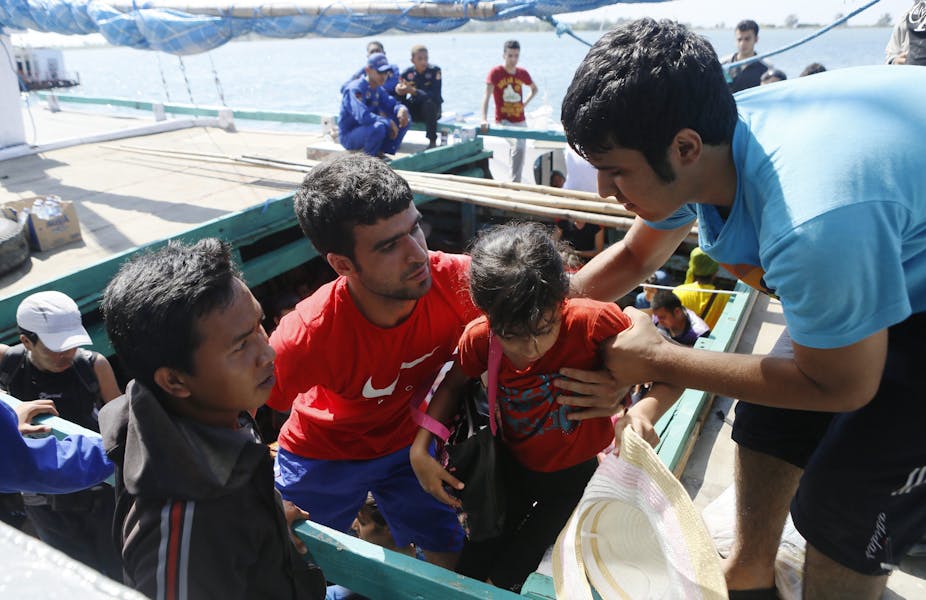The people smugglers business model is phrase that has entered the Australian political lexicon if only through sheer repetition.
It has barely left the lips of prime minister Kevin Rudd or immigration minister Tony Burke since the plan to send asylum seekers arriving by boat to Papua New Guinea, where they will be settled if found to be genuine refugees, was announced.
But what does this so-called business model look like? Indeed, does it even exist? Could it be that rather than having a simple “business model”, people smuggling is a more complex and fluid phenomenon that will prove immensely difficult, if not impossible, to stop?
Having conducted extensive ethnographic fieldwork among smuggling facilitators, it is clear to me that Rudd’s recent decision to send refugee seekers to an alternative location does little to destroy, even alter the “smuggling model” he vehemently trusts the plan will undermine.
And that is because human smugglers are not in the business of selling permanent residence; in fact they do not even sell the idea of a specific country at all.
While there are significant limitations to the idea of human smuggling as fitting into a specific model I should start by noting that human smugglers are first and foremost, transit brokers, facilitators of specific segments of a journey.
As such, their role is to identify routes that may ease (amid the precariousness and drama involved) the challenges surrounding the extra-legal nature of such travels. Furthermore, we should not forget human smugglers work with a highly specific clientele: those who have consistently been denied access to any kind of official recognition from a nation-state and who are therefore unable to travel under the protection provided by visas or passports.
Threatening refugee seekers with the inability to settle in Australia does not constitute a strong or effective deterrence mechanism. At the time they embark in their journey refugees’ main focus is not on the logistics of resettlement, but on being able to leave behind the extreme conditions they face.
To the smugglers, the Australian government’s decision simply means they have to come up with new routes for a segment of clients that is unlikely to disappear. As witnessed along the US border during the years that followed the implementation of Operations Hold the Line and Gatekeeper, which sought to reduce extra-legal crossings from Mexico, closing access to specific points along borders is only effective temporarily.
In the long run, the measure simply allowed for the emergence of alternative crossing points (many of them involving more remote, dangerous routes) and for the development of the human smuggling market in Arizona (the United States’ top human smuggling hub).

With the relocation of refugees to PNG, Australia may be actually contributing to the creation of a new smuggling centre in the region – one that is not subjected to the limitations faced by Indonesia (increased surveillance, limited visas) and from where even more daring transits to other countries (including Australia itself) can be planned and carried out.
Rudd claimed the policy would go forward despite smugglers’ efforts to test Australia’s resolve. But what is the human cost of a measure like this? The boats have not stopped, with 60 people feared drowned earlier this week.
Again, a comparison is warranted. According to reports from Arizona’s Pima County Medical Examiner’s Office, between 2000 and 2005 (the years that followed the implementation of Hold the Line and Gatekeeper), a total of 802 corpses were recovered along the border crossing trail, compared to the 125 during the 1990-1999 period. By 2012, an additional 1314 deaths had been recorded.
Finally, smuggling’s success is dependent on a high level of flexibility, one that does not follow a pre-established logic because of the very uncertainty surrounding extra-legal crossings. To think that altering one variable in the smuggling equation will do anything to deter the resolve of refugee seekers to reach a destination is naïve at best.
There may be some restructuring in the local smuggling market. Some smuggler facilitators may have stopped operating for now, waiting for the political storm to pass. Others may actually continue to send refugee seekers by boat under false pretences and even many refugee seekers themselves may be desperately looking for smugglers willing to help them travel despite the announcement.
The number of people who have arrived since the plan was announced keeps increasing – a grim reminder that for as long as the structural mechanisms that limit the mobility of refugee seekers stay in place, the boats, and the crews who organise them, will merely continue to operate from the coasts of Malaysia, loaded with human beings heading into uncertain futures.

